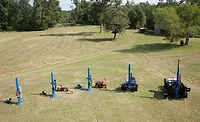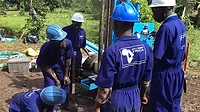Maintenance Extends Life of Compact Water Well Drilling Rigs
Clean, accessible water — one of life’s basic necessities — saves lives around the world, but in some regions, including Africa, the Caribbean, Central America and South America, villagers walk miles to collect water from a potentially contaminated source. Missionaries improve the villagers’ quality of life by drilling community water wells. Even in the best of circumstances, a maintenance or repair issue can emerge when drilling a well, potentially delaying the project significantly — or, in the worst case, indefinitely. And with their limited timeframes, missionaries seldom have time for a standstill in production.
Article Index:
Timing is critical if a breakdown occurs on a drill site. Anxious villagers surround the missionaries, waiting eagerly for the moment they’ll no longer have to walk several miles for hydration or to draw water from a river contaminated by agricultural runoff. They can tell if something goes awry, even if they might not speak the same language. Missionaries can’t buy parts from the nearest hardware store, usually because one doesn’t exist or the roads are barely passable, slowing travel to just above a crawl. And a scorching sun overheats everyone as well as their frustrations.
Routine maintenance ensures missionaries don’t get stuck with their bits down. This includes checking as well as servicing moving and nonmoving parts as needed, and working with a reliable manufacturer that can provide around-the-clock support.
Chain Gangs and Greasers
Missionaries often think routine maintenance doesn’t need to be done often. In reality, making it a daily habit prolongs the life of the drill and minimizes the chance of a critical breakdown. Checking the grease levels and drive chain is always a good place to start, since it leads the operator around most of the drill’s major components.
To ensure proper lubrication, inject molybdenum-based grease into all grease fittings, which are usually found on the side of the drill’s drawworks, swivel and mast. Most manufacturers recommend using a molybdenum-based grease because it remains viscous even at high temperatures, which means that it stays inside the fitting longer than oil.
Use a grease gun to inject grease — about two to three pumps — into grease fittings before starting the drill and every few hours while the drill is operating. The slide pads on the drawworks and mast need cleaning and lubrication after about eight hours of operation so the drivehead can lift smoothly and quickly. Use a light film of silicone spray to prevent corrosion from forming.
While greasing the drawworks and mast, inspect the drive chain to ensure it is tight and properly lubricated. Ensure the drive chain has minimal slack and, to prevent rusting, lubricate it with a heavy-weight oil or grease if dry. The drive chain is crucial to maintain because the drawworks uses it to raise or lower the drill pipe in the borehole, much like the drill line on a large drilling rig.
Check the drive chain after about four hours of drilling and remove any slack, as necessary. A loose drive chain slaps against the drill’s mast while boring through overburden or rock formations. Processes for adjusting drill tension vary between manufacturers, and some design rotary drills with this type of maintenance in mind. For example, some manufacturers design rotary drills that make accessing the chain’s adjustment screw and locking nut as simple as possible, for instance by removing a pin or loosening a single bolt. This significantly minimizes downtime. To adjust the tension, open the rotary drive assembly and swing the drivehead to the side to access an adjustment screw and locking nut. Hold the adjustment screw and loosen the locking nut. Then, tighten the adjustment nut until nearly all the drive chain’s slack is removed. There should be a little slack because it prevents the chain from getting stuck at the top of the mast, but not so much that it slaps against the mast. After getting rid of the slack, tighten the locking nut and secure the drivehead into place.
Like the drawworks and mast, the water swivel needs routine greasing and maintenance. Add grease to the water swivel after about four hours of operation, since it is already preloaded with grease. It should be added while the drill stem rotates slowly — less than 10 rpm — and immediately after operating, while the drill is still warm, so heated grease can flow into the wear areas. With proper greasing and maintenance, the water swivel should last the life of the drill.
Take care not to over-grease the water swivel because it might prematurely wear its swivel shaft. To avoid this, only pump grease into the water swivel until it resists additional grease. If the water swivel seizes while lubricating, use a sharp object, such as a flat screwdriver head, to depress the ball check in the grease fittings, releasing extra pressure.
After inspecting and lubricating the drive chain, swivel, drawworks and mast, run through a daily checklist of bolts, pipes and plates.
Bits and Pipes, Bolts and Plates
Maintenance shouldn’t stop with lubricating the moving parts and inspecting the drive chain. Inspect the drill’s nonmechanical parts, including drill bits, mounting bolts, drill pipes and the slip plate. They need regular maintenance because it prevents minor operating issues from becoming large repairs.
Missionaries get the most use from drill bits when they’re inspected and maintained regularly. Before fitting the bit to the drill pipe, inspect the bit for any damaged threads or worn teeth. Damaged threads can make the bit hard — or sometimes impossible — to remove from the drill stem when it comes time to change a bit. Plus, worn teeth can’t penetrate as efficiently as well-maintained or new bits.
To achieve the maximum service life of the bits, clean the box threads with a wire brush to remove any dirt and grease, and remove any soil from the bit and coat with oil before storing to prevent rust.
Like drill bits, properly cleaning and storing drill pipes allows the pipes to achieve a full service life. After drilling each hole, clean both the pin and box threads with a wire brush to remove any dirt or grease residue. Afterward, clean any soil from the pipe and replace the thread protector caps before storing it in a trailer. Some manufacturers incorporate drill racks along with the drills to make storing and transporting drill pipes easy. These practices prevent rust, which can cause pipes to break inside a borehole if they’re not properly maintained.
All mounting bolts on the J-latch, water swivel and hydraulic motor need proper tightening. The bolts minimize vibrations created by the drill, preventing damage to the motor shaft or the water swivel. A loose bolt on the J-latch can break off, becoming difficult to remove. Missionaries can detect a loose mounting bolt if they hear any extra vibrations while running the drill. Some manufacturers include a torque guide inside the drill’s operator manual to ensure these mounting bolts are properly tightened.
Clear slip plates of grease and soil to reduce the chance of rust, as well as ensure they are centered to minimize pressure on the water swivel. To adjust the slip plate, first raise the rotary head and screw a drill pipe onto the swivel stem over an open borehole. Next, put the slip plate onto the angle bracket and loosen the mounting bolts. Lower the pipe partially through the hole in the slip plate and shut the clamps, making sure they are seated. Continue to lower the rotary head until the upper tool joint enters the hole, and rotate the pipe as necessary, allowing the breakout lugs to pass through the slip plate. Now that the plate is centered, tighten the mounting bolts.
Eliminating Downtime at the Source
If a drill seems to be running a little off, isolate the issue by using sight, hearing and touch. Odd sounds are easy indications that something is wrong, such as loose bolts, a loose chain or a worn bearing. The operators’ manual is the first line of defense against servicing downtime. Reference the manual to find a solution after isolating the issue, such as a slapping drive chain.
Some manufacturers include service kits with their drills that include common wear parts and required tools, making in-field repairs quick and easy. For instance, if missionaries can’t stop water from leaking out of the water swivel — even after adding grease — they can replace it using the tools and parts within the service kit. This significantly minimizes downtime since they do not have to wait for a part to ship. Rotary drills should be as reliable as the manufacturer because the last thing missionaries need is to be stuck in unfamiliar territory with an inoperable drill. Some manufacturers design their drills to withstand rugged drilling conditions — including the volcanic soil of Central America, the Caribbean and South America — by incorporating high-strength welded steel frames and easy-to-access maintenance points to minimize downtime in the field and in the shop. Working with a reliable manufacturer gives missionaries peace of mind if an operators’ manual doesn’t have a solution. Some manufacturers might claim they provide quality service and support, only to fall off the radar once the drill ships from the factory. Luckily, that is not true for all. Some manufacturers go so far as to provide around-the-clock support, visiting the drill while it’s in the field, and even designing new drills using customer feedback as their guide. To find a reliable manufacturer, check for company reviews using a search engine or contact other customers to learn about their experience.
Regularly maintaining a rotary drill from a reliable manufacturer provides value to missionaries and the work they do for villagers living without clean water. It helps ensure that missionaries leave with a life-rewarding experience, as well as knowing they kept good on their promise to provide accessible, clean drinking water.
For more information, email sales@littlebeaver.com or visit www.lonestardrills.com.
Looking for a reprint of this article?
From high-res PDFs to custom plaques, order your copy today!





